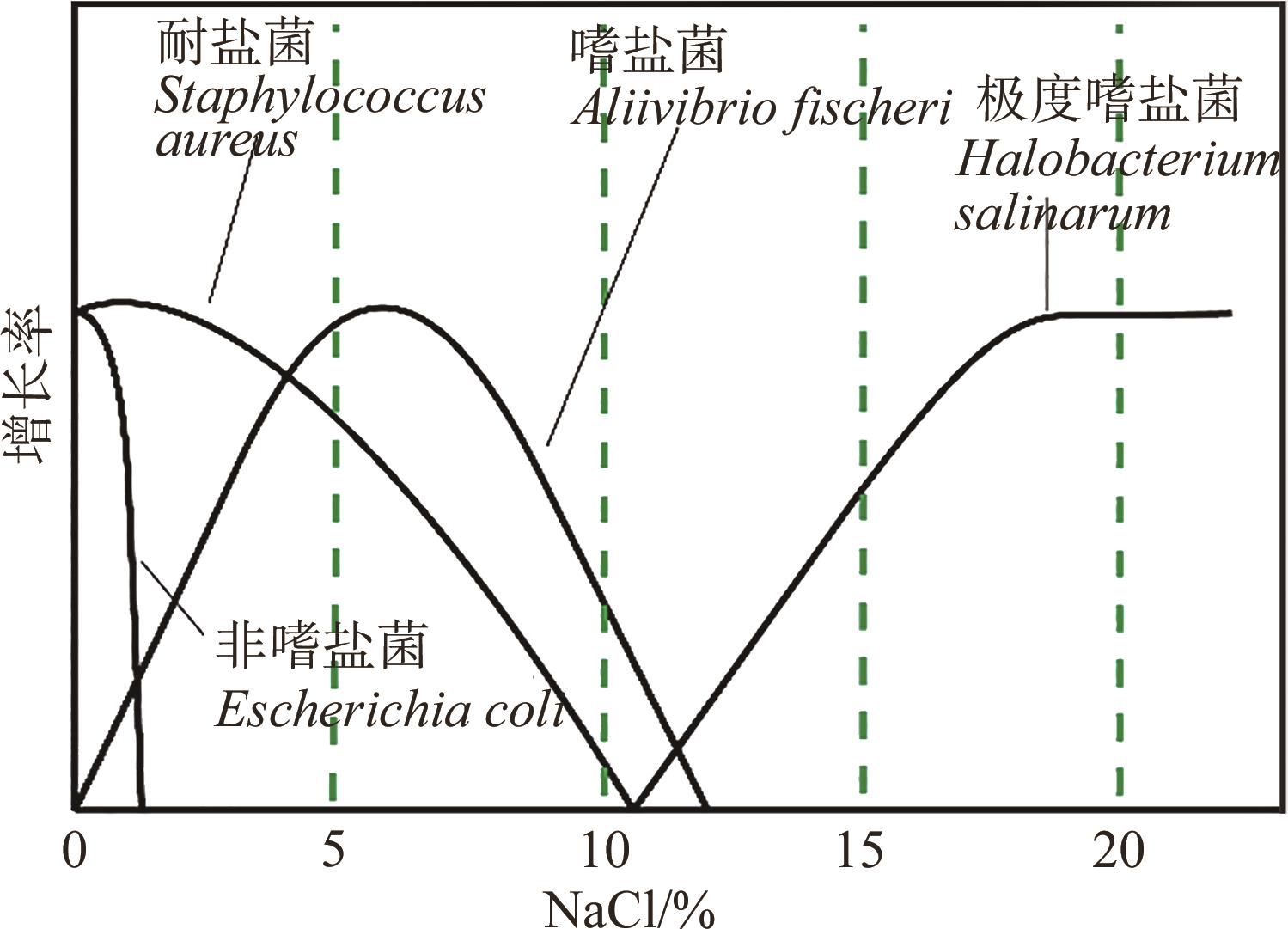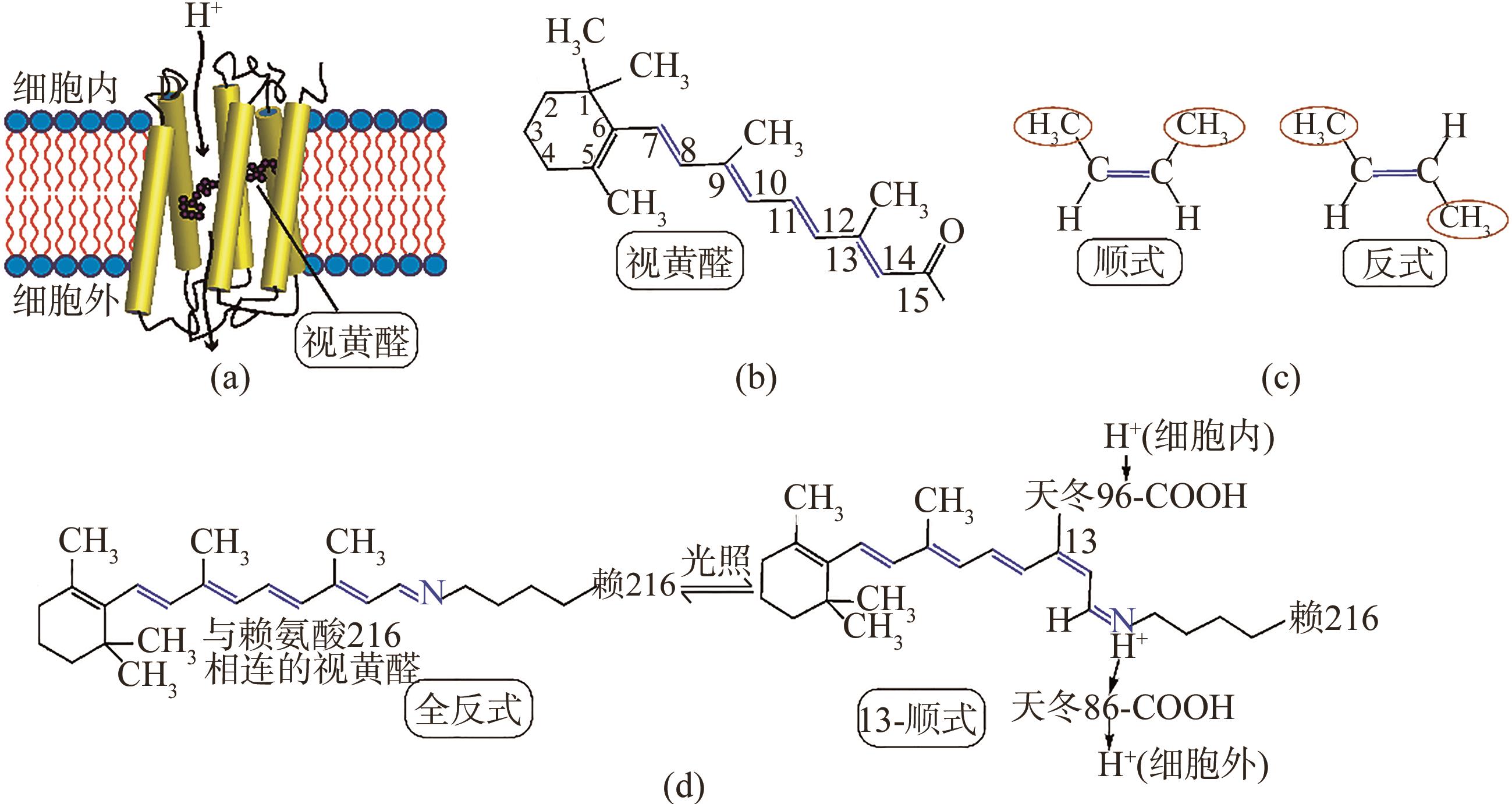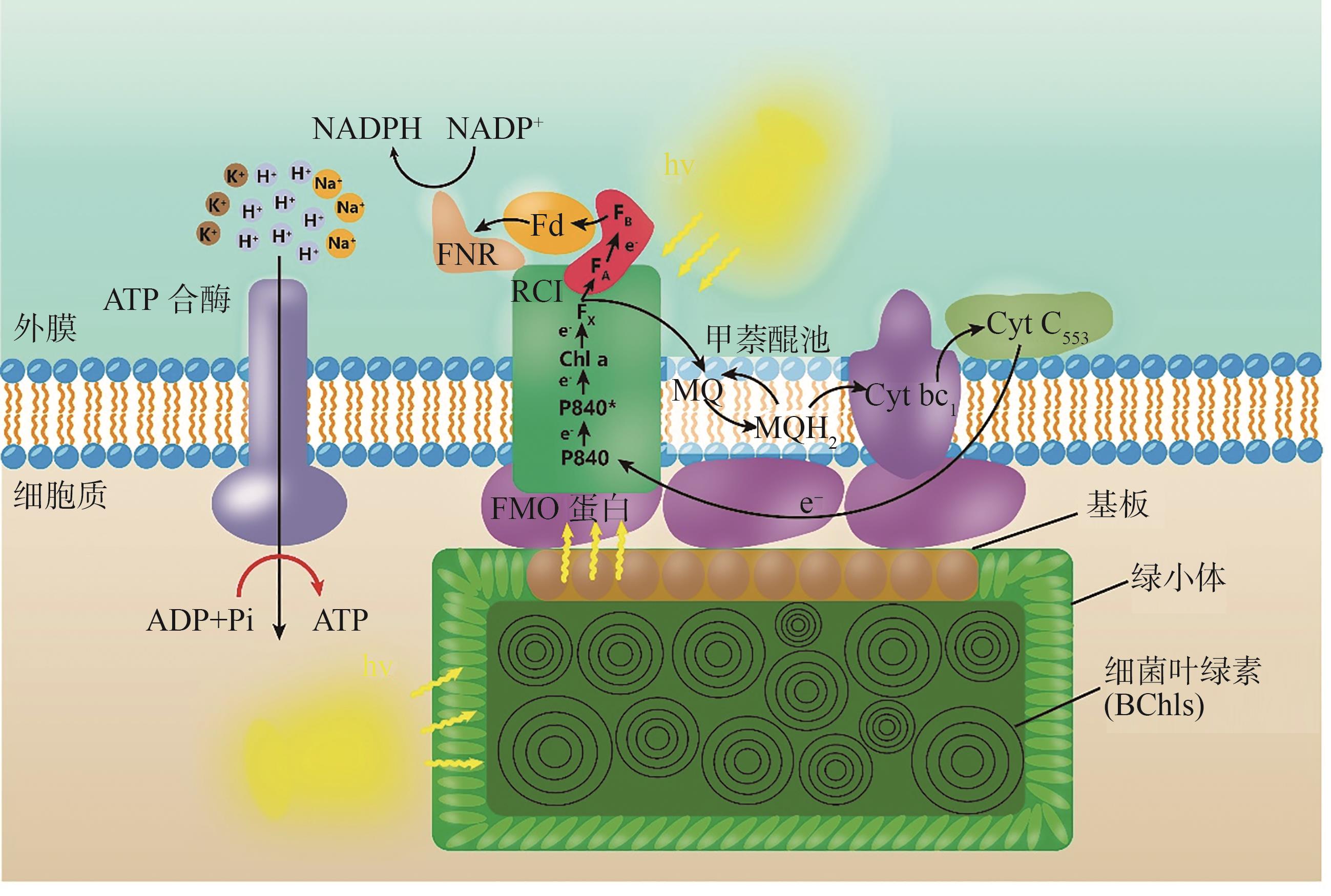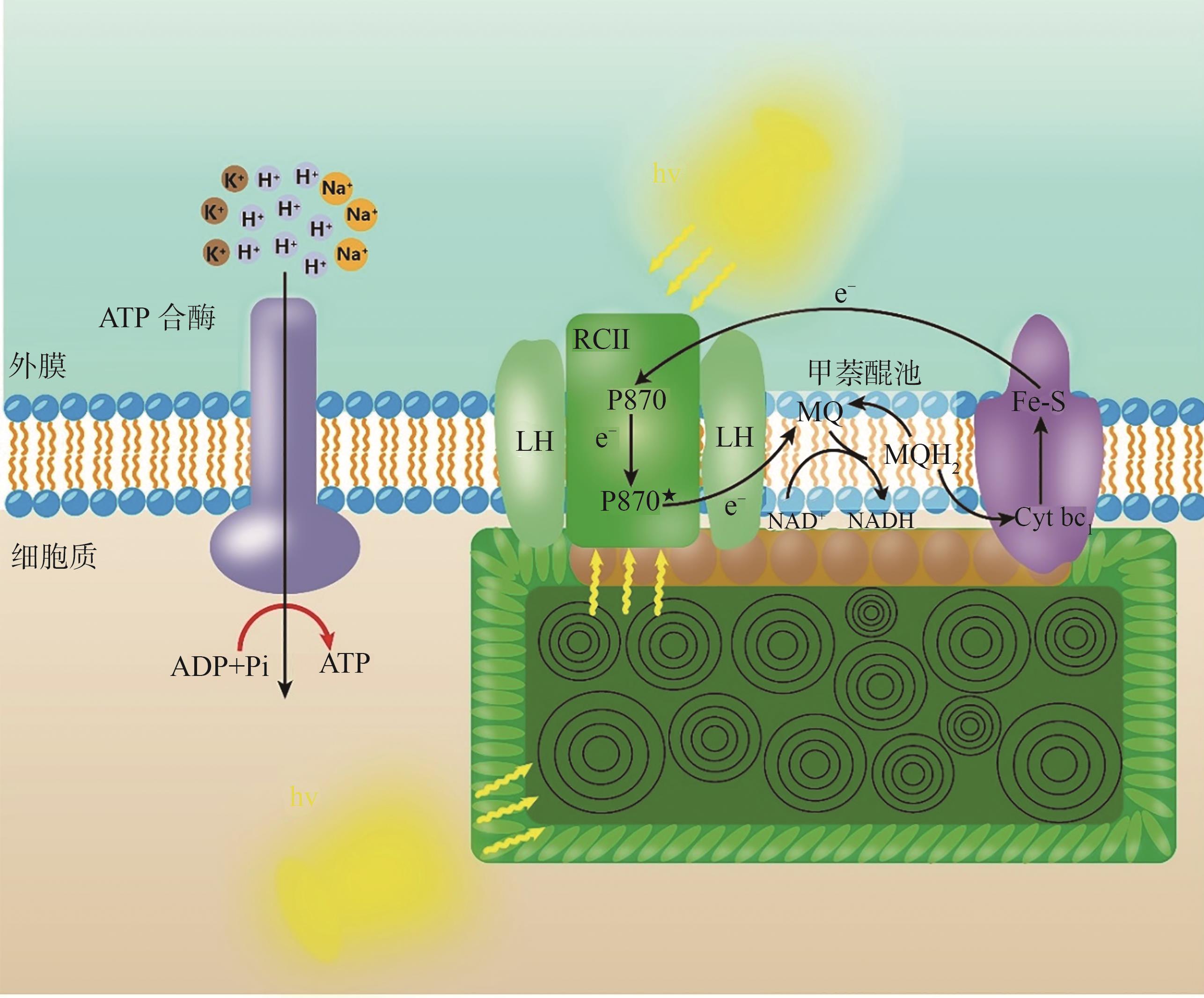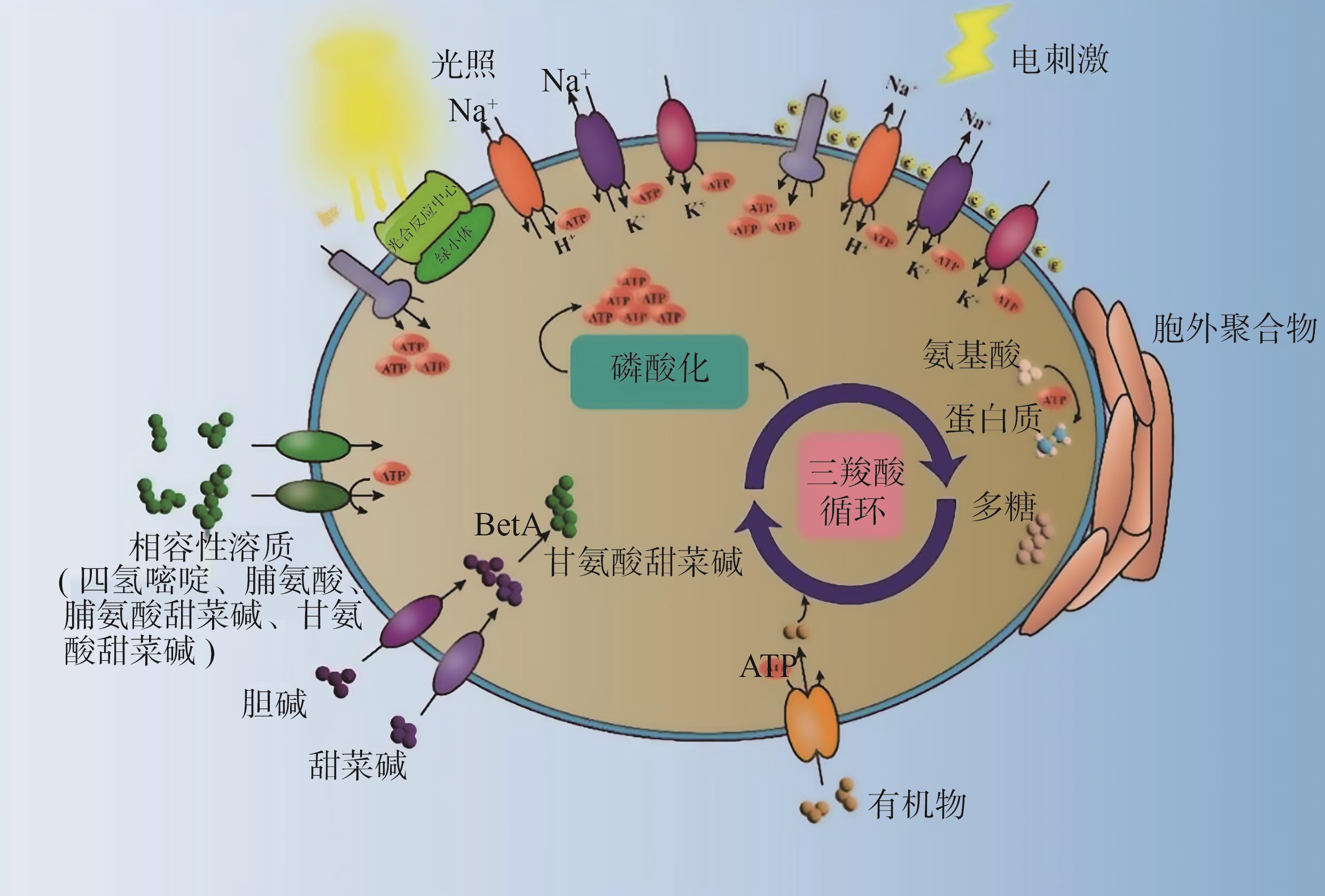Chemical Industry and Engineering Progress ›› 2025, Vol. 44 ›› Issue (1): 465-476.DOI: 10.16085/j.issn.1000-6613.2023-2257
• Resources and environmental engineering • Previous Articles Next Articles
Regulation of salt tolerance in bacteria and its application in hypersaline BNR process
TIAN Qing1,2( ), LIU Qingmeng1, LI Fang1,2, YANG Bo1,2, ZHANG Siyuan1, GUAN Ziliang1
), LIU Qingmeng1, LI Fang1,2, YANG Bo1,2, ZHANG Siyuan1, GUAN Ziliang1
- 1.College of Environmental Science and Engineering, Donghua University, Shanghai 201600, China
2.State Environmental Protection Engineering Center for Pollution Treatment and Control in Textile Industry, Shanghai 201600, China
-
Received:2023-12-25Revised:2024-02-22Online:2025-02-13Published:2025-01-15 -
Contact:TIAN Qing
细菌的耐盐调控及其在高盐生物脱氮除磷工艺中的应用
田晴1,2( ), 刘青盟1, 李方1,2, 杨波1,2, 张思远1, 关自良1
), 刘青盟1, 李方1,2, 杨波1,2, 张思远1, 关自良1
- 1.东华大学环境科学与工程学院,上海 201600
2.国家环境保护纺织工业污染防治工程技术中心,上海 201620
-
通讯作者:田晴 -
作者简介:田晴(1972—),女,博士,副教授,研究方向为污水生物脱氮除磷。E-mail:tq2004@dhu.edu.cn。 -
基金资助:国家自然科学基金(21777024);国家重点研发计划(2019YFC0408503)
CLC Number:
Cite this article
TIAN Qing, LIU Qingmeng, LI Fang, YANG Bo, ZHANG Siyuan, GUAN Ziliang. Regulation of salt tolerance in bacteria and its application in hypersaline BNR process[J]. Chemical Industry and Engineering Progress, 2025, 44(1): 465-476.
田晴, 刘青盟, 李方, 杨波, 张思远, 关自良. 细菌的耐盐调控及其在高盐生物脱氮除磷工艺中的应用[J]. 化工进展, 2025, 44(1): 465-476.
share this article
Add to citation manager EndNote|Ris|BibTeX
URL: https://hgjz.cip.com.cn/EN/10.16085/j.issn.1000-6613.2023-2257
| 反应式 | 自由能 | 参考文献 |
|---|---|---|
CH3COO- + 4S0 + 4H2O 4HS-+ 2HCO3- + 5H+ | ΔG⊖=-6.6kJ pH=10时ΔG⊖'=-91.9kJ | [ |
C3H5O2- + 3H2O CH3COO- + HCO3- + 3H2 + H+ | ΔG⊖=+76.4kJ pH=10时ΔG⊖'= +59.4kJ | [ |
| 反应式 | 自由能 | 参考文献 |
|---|---|---|
CH3COO- + 4S0 + 4H2O 4HS-+ 2HCO3- + 5H+ | ΔG⊖=-6.6kJ pH=10时ΔG⊖'=-91.9kJ | [ |
C3H5O2- + 3H2O CH3COO- + HCO3- + 3H2 + H+ | ΔG⊖=+76.4kJ pH=10时ΔG⊖'= +59.4kJ | [ |
| 微生物 | 反应式 | 自由能 | 参考文献 |
|---|---|---|---|
| 嗜盐硝化球菌 | NH4+ + 1.5O2 NH3 + 1.5O2 | ΔG⊖ = -274.6kJ pH=10时ΔG⊖'= -304.7kJ | [ |
| 嗜盐硫杆菌 | HS- + 2O2 | ΔG⊖= -797kJ pH=9时ΔG⊖'= -808kJ | [ |
| 嗜盐厌氧菌 | CH3COO- + 4S0 + 4H2O | ΔG⊖'= -6.6kJ pH=10时ΔG⊖'= -91.9kJ | [ |
| 嗜钠脱硫菌 | 2C3H5O3- | ΔG⊖= -112.4kJ pH=10时ΔG⊖'= -129.5kJ | [ |
| 微生物 | 反应式 | 自由能 | 参考文献 |
|---|---|---|---|
| 嗜盐硝化球菌 | NH4+ + 1.5O2 NH3 + 1.5O2 | ΔG⊖ = -274.6kJ pH=10时ΔG⊖'= -304.7kJ | [ |
| 嗜盐硫杆菌 | HS- + 2O2 | ΔG⊖= -797kJ pH=9时ΔG⊖'= -808kJ | [ |
| 嗜盐厌氧菌 | CH3COO- + 4S0 + 4H2O | ΔG⊖'= -6.6kJ pH=10时ΔG⊖'= -91.9kJ | [ |
| 嗜钠脱硫菌 | 2C3H5O3- | ΔG⊖= -112.4kJ pH=10时ΔG⊖'= -129.5kJ | [ |
| 1 | Nina GUNDE-CIMERMAN, Ana PLEMENITAŠ, OREN Aharon. Strategies of adaptation of microorganisms of the three domains of life to high salt concentrations[J]. FEMS Microbiology Reviews, 2018, 42(3): 353-375. |
| 2 | PLOMINSKY Alvaro M, Carlos HENRÍQUEZ-CASTILLO, DELHERBE Nathalie, et al. Distinctive archaeal composition of an artisanal crystallizer pond and functional insights into salt-saturated hypersaline environment adaptation[J]. Frontiers in Microbiology, 2018, 9: 1800. |
| 3 | BREMER Erhard, Reinhard KRÄMER. Responses of microorganisms to osmotic stress[J]. Annual Review of Microbiology, 2019, 73: 313-334. |
| 4 | CORSINO Santo Fabio, CAPODICI Marco, TORREGROSSA Michele, et al. A comprehensive comparison between halophilic granular and flocculent sludge in withstanding short and long-term salinity fluctuations[J]. Journal of Water Process Engineering, 2018, 22: 265-275. |
| 5 | 陆浩良, 田晴, 朱艳彬, 等. 耐低温生物脱氮机制与对策研究进展[J]. 化工进展, 2020, 39(1): 372-379. |
| LU Haoliang, TIAN Qing, ZHU Yanbin, et al. State of the art for mechanisms and countermeasures of low temperature biological nitrogen removal[J]. Chemical Industry and Engineering Progress, 2020, 39(1): 372-379. | |
| 6 | 杨建鹏, 张健, 田晴, 等. 内源碳PHA的贮存对混合菌群耐低温特性的影响[J]. 环境科学, 2019, 40(4): 1914-1921. |
| YANG Jianpeng, ZHANG Jian, TIAN Qing, et al. Effect of intracellular carbon source (PHA) storage on the mixed growth microbial community resistance to low temperature[J]. Environmental Science, 2019, 40(4): 1914-1921. | |
| 7 | OREN A. Bioenergetic aspects of halophilism[J]. Microbiology and Molecular Biology Reviews: MMBR, 1999, 63(2): 334-348. |
| 8 | KUMAR Satish, PAUL Dhiraj, BHUSHAN Bharat, et al. Traversing the “Omic” landscape of microbial halotolerance for key molecular processes and new insights[J]. Critical Reviews in Microbiology, 2020, 46(6): 631-653. |
| 9 | ARAKAWA Tsutomu, YAMAGUCHI Rui, TOKUNAGA Hiroko, et al. Unique features of halophilic proteins[J]. Current Protein & Peptide Science, 2017, 18(1): 65-71. |
| 10 | LU Mingji, DANIEL Rolf. A novel carboxylesterase derived from a compost metagenome exhibiting high stability and activity towards high salinity[J]. Genes, 2021, 12(1): 122. |
| 11 | FU Hsu-Yuan, YI Hsiu-Ping, LU Yen-Hsu, et al. Insight into a single halobacterium using a dual-bacteriorhodopsin system with different functionally optimized pH ranges to cope with periplasmic pH changes associated with continuous light illumination[J]. Molecular Microbiology, 2013, 88(3): 551-561. |
| 12 | Oscar JUÁREZ, BARQUERA Blanca. Insights into the mechanism of electron transfer and sodium translocation of the Na(+)-pumping NADH: Quinone oxidoreductase[J]. Biochimica et Biophysica Acta, 2012, 1817(10): 1823-1832. |
| 13 | LAI M C, SOWERS K R, ROBERTSON D E, et al. Distribution of compatible solutes in the halophilic methanogenic archaebacteria[J]. Journal of Bacteriology, 1991, 173(17): 5352-5358. |
| 14 | HAMAIDE F, KUSHNER D J, SPROTT G D. Proton motive force and Na+/H+ antiport in a moderate halophile[J]. Journal of Bacteriology, 1983, 156(2): 537-544. |
| 15 | YANG Lifu, JIANG Juquan, ZHANG Bo, et al. A primary sodium pump gene of the moderate halophile Halobacillus dabanensis exhibits secondary antiporter properties[J]. Biochemical and Biophysical Research Communications, 2006, 346(2): 612-617. |
| 16 | GOLDBERG E B, ARBEL T, CHEN J, et al. Characterization of a Na+/H+ antiporter gene of Escherichia coli [J]. Proceedings of the National Academy of Sciences of the United States of America, 1987, 84(9): 2615-2619. |
| 17 | SAUM Stephan H, PFEIFFER Friedhelm, PALM Peter, et al. Chloride and organic osmolytes: A hybrid strategy to cope with elevated salinities by the moderately halophilic, chloride-dependent bacterium Halobacillus halophilus[J]. Environmental Microbiology, 2013, 15(5): 1619-1633. |
| 18 | SONG Qi, CHEN Xiaoguang, HUA Yu, et al. Biological treatment processes for saline organic wastewater and related inhibition mechanisms and facilitation techniques: A comprehensive review[J]. Environmental Research, 2023, 239: 117404. |
| 19 | LU Chenshun, QIU Jinming, YANG Yang, et al. A review of anaerobic granulation under high-salinity conditions: Mechanisms, influencing factors and enhancement strategies[J]. Journal of Water Process Engineering, 2023, 55: 104227. |
| 20 | LI Jing, SHI Wansheng, JIANG Changwang, et al. Evaluation of potassium as promoter on anaerobic digestion of saline organic wastewater[J]. Bioresource Technology, 2018, 266: 68-74. |
| 21 | GALINSKI Erwin A, TRÜPER Hans G. Microbial behaviour in salt-stressed ecosystems[J]. FEMS Microbiology Reviews, 1994, 15(2/3): 95-108. |
| 22 | PFLÜGER K, MÜLLER V. Transport of compatible solutes in extremophiles[J]. Journal of Bioenergetics and Biomembranes, 2004, 36(1): 17-24. |
| 23 | AVERHOFF Beate, Volker MÜLLER. Exploring research frontiers in microbiology: Recent advances in halophilic and thermophilic extremophiles[J]. Research in Microbiology, 2010, 161(6): 506-514. |
| 24 | LEÓN María J, HOFFMANN Tamara, Cristina SÁNCHEZ-PORRO, et al. Compatible solute synthesis and import by the moderate halophile Spiribacter salinus: Physiology and genomics[J]. Frontiers in Microbiology, 2018, 9: 108. |
| 25 | GALINSKI E A. Compatible solutes of halophilic eubacteria: Molecular principles, water-solute interaction, stress protection[J]. Experientia, 1993, 49(6): 487-496. |
| 26 | WILLIAMSON John D, JENNINGS Dianne B, GUO Weiwen, et al. Sugar alcohols, salt stress, and fungal resistance: Polyols—Multifunctional plant protection?[J]. Journal of the American Society for Horticultural Science, 2002, 127(4): 467-473. |
| 27 | HELD Christoph, SADOWSKI Gabriele. Compatible solutes: Thermodynamic properties relevant for effective protection against osmotic stress[J]. Fluid Phase Equilibria, 2016, 407: 224-235. |
| 28 | WANG Jinxiu, LIU Yang, MA Yecheng, et al. Research progress regarding the role of halophilic and halotolerant microorganisms in the eco-environmental sustainability and conservation[J]. Journal of Cleaner Production, 2023, 418: 138054. |
| 29 | BANDA Joseph Frazer, LU Yanchun, HAO chunbo, et al. The effects of salinity and ph on microbial community diversity and distribution pattern in the brines of soda lakes in badain jaran desert, China[J]. Geomicrobiology Journal, 2020. 37(1): 1-12. |
| 30 | SOROKIN Dimitry Y, RUSANOV Igor I, PIMENOV Nikolai V, et al. Sulfidogenesis under extremely haloalkaline conditions in soda lakes of Kulunda Steppe (Altai, Russia)[J]. FEMS Microbiology Ecology, 2010, 73(2): 278-290. |
| 31 | SOROKIN D Y, DETKOVA E N, MUYZER G. Propionate and butyrate dependent bacterial sulfate reduction at extremely haloalkaline conditions and description of Desulfobotulus alkaliphilus sp. nov[J]. Extremophiles, 2010, 14(1): 71-77. |
| 32 | DORADOR Cristina, BUSEKOW Annika, VILA Irma, et al. Molecular analysis of enrichment cultures of ammonia oxidizers from the Salar de Huasco, a high altitude saline wetland in northern Chile[J]. Extremophiles, 2008, 12(3): 405-414. |
| 33 | SYDOW Ulrike, WOHLAND Pia, WOLKE Irmgard, et al. Bioenergetics of the alkaliphilic sulfate-reducing bacterium desulfonatronovibrio hydrogenovorans[J]. Microbiology, 2002, 148(Pt 3): 853-860. |
| 34 | ZHILINA Tatjana N, ZAVARZIN Georgy A, DETKOVA Ekaterina N, et al. Natroniella acetigena gen. nov. sp. nov., an extremely haloalkaliphilic, homoacetic bacterium: A new member of haloanaerobiales[J]. Current Microbiology, 1996, 32(6): 320-326. |
| 35 | CUI Jinyu, SUN Tao, CHEN Lei, et al. Engineering salt tolerance of photosynthetic cyanobacteria for seawater utilization[J]. Biotechnology Advances, 2020, 43: 107578. |
| 36 | LAKE J A, CLARK M W, HENDERSON E, et al. Eubacteria, halobacteria, and the origin of photosynthesis: The photocytes[J]. Proceedings of the National Academy of Sciences of the United States of America, 1985, 82(11): 3716-3720. |
| 37 | IMHOFF J F. True marine and halophilic anoxygenic phototrophic bacteria[J]. Archives of Microbiology, 2001, 176(4): 243-254. |
| 38 | SMITIENKO Olga A, FELDMAN Tatiana B, PETROVSKAYA Lada E, et al. Comparative femtosecond spectroscopy of primary photoreactions of Exiguobacterium sibiricum rhodopsin and Halobacterium salinarum bacteriorhodopsin[J]. The Journal of Physical Chemistry B, 2021, 125(4): 995-1008. |
| 39 | Alice VERCHÈRE, Weilin OU, PLOIER Birgit, et al. Light-independent phospholipid scramblase activity of bacteriorhodopsin from Halobacterium salinarum [J]. Scientific Reports, 2017, 7(1): 9522. |
| 40 | NISSEN Hilde, DUNDAS Ian D. Rhodospirillum salinarum sp. nov., a halophilic photosynthetic bacterium isolated from a Portuguese saltern[J]. Archives of Microbiology, 1984, 138(3): 251-256. |
| 41 | Jörg OVERMANN, VAN GEMERDEN Hans. Microbial interactions involving sulfur bacteria: Implications for the ecology and evolution of bacterial communities[J]. FEMS Microbiology Reviews, 2000, 24(5): 591-599. |
| 42 | CHEN Jinghua, WU Hangjun, XU Caihuang, et al. Architecture of the photosynthetic complex from a green sulfur bacterium[J]. Science, 2020, 370(6519): eabb6350. |
| 43 | LINNANTO Juha M, KORPPI-TOMMOLA Jouko E I. Investigation on chlorosomal antenna geometries: Tube, lamella and spiral-type self-aggregates[J]. Photosynthesis Research, 2008, 96(3): 227-245. |
| 44 | KUNSEL T, GÜNTHER L M, KÖHLER J, et al. Probing size variations of molecular aggregates inside chlorosomes using single-object spectroscopy[J]. Journal of Chemical Physics, 2021, 155(12): 124310. |
| 45 | Gregory S ORF, BLANKENSHIP Robert E. Chlorosome antenna complexes from green photosynthetic bacteria[J]. Photosynthesis Research, 2013, 116(2/3): 315-331. |
| 46 | KUNDU Mousumi, CHANDRASHEKAR C M. Non-markovianity between site pairs in FMO complex using discrete-time quantum jump model[J]. ACS Omega, 2022, 7(51): 48067-48074. |
| 47 | BRYANT Donald A, FRIGAARD Niels-Ulrik. Prokaryotic photosynthesis and phototrophy illuminated[J]. Trends in Microbiology, 2006, 14(11): 488-496. |
| 48 | AZAI Chihiro, TSUKATANI Yusuke, ITOH Shigeru, et al. C-type cytochromes in the photosynthetic electron transfer pathways in green sulfur bacteria and heliobacteria[J]. Photosynthesis Research, 2010, 104(2/3): 189-199. |
| 49 | ALLEN John F. A redox switch hypothesis for the origin of two light reactions in photosynthesis[J]. FEBS Letters, 2005, 579(5): 963-968. |
| 50 | ZHANG Linfang, HUANG Xiaodan, CHEN Wenting, et al. Microalgae-assisted heterotrophic nitrification-aerobic denitrification process for cost-effective nitrogen and phosphorus removal from high-salinity wastewater: Performance, mechanism, and bacterial community[J]. Bioresource Technology, 2023, 390: 129901. |
| 51 | LIAO Yang, BIAN Jiyong, MIAO Shiyu, et al. Regulation of denitrification performance and microbial topology by lights: Insight into wavelength effects towards microbiota[J]. Water Research, 2023, 232: 119434. |
| 52 | FENG Huajun, ZHANG Xueqin, GUO Kun, et al. Electrical stimulation improves microbial salinity resistance and organofluorine removal in bioelectrochemical systems[J]. Applied and Environmental Microbiology, 2015, 81(11): 3737-3744. |
| 53 | BLANK Martin. Do electromagnetic fields interact with electrons in the Na, K-ATPase?[J]. Bioelectromagnetics, 2005, 26(8): 677-683. |
| 54 | OHBA Tetsuro, UEMURA Kunihiko, NABETANI Hiroshi. Changes in biosynthesis of exopolysaccharide in Lactococcus lactis subspecies cremoris treated by moderate pulsed electric field treatment[J]. Bioscience, Biotechnology, and Biochemistry, 2017, 81(4): 724-734. |
| 55 | HUANG Wenli, WANG Wenlong, SHI Wansheng, et al. Use low direct current electric field to augment nitrification and structural stability of aerobic granular sludge when treating low COD/NH4-N wastewater[J]. Bioresource Technology, 2014, 171: 139-144. |
| 56 | CHEN Long, ZHOU Liting, DING Yangcheng, et al. Enhancing microbial salt tolerance through low-voltage stimulation for improved p-chloronitrobenzene (p-CNB) removal in high-salinity wastewater[J]. Science of the Total Environment, 2023, 905: 167164. |
| 57 | JUNG Sungyup, LEE Jechan, PARK Young-Kwon, et al. Bioelectrochemical systems for a circular bioeconomy[J]. Bioresource Technology, 2020, 300: 122748. |
| 58 | PIERRA Mélanie, CARMONA-MARTÍNEZ Alessandro A, TRABLY Eric, et al. Specific and efficient electrochemical selection of Geoalkalibacter subterraneus and Desulfuromonas acetoxidans in high current-producing biofilms[J]. Bioelectrochemistry, 2015, 106: 221-225. |
| 59 | LIU Weifeng, WU Yaoting. Simultaneous nitrification, denitrification and electricity recovery of Halomonas strains in single chamber microbial fuel cells for seawater sewage treatment[J]. Journal of Environmental Chemical Engineering, 2021, 9(6): 106761. |
| 60 | QU Zhaopeng, LI Jin, HU Zhi, et al. Microbial electrolysis drives ammonium removal from saline wastewater through marine anammox bacteria[J]. Chemical Engineering Journal, 2023, 477: 147024. |
| 61 | ZHANG Linfang, HUANG Xiaodan, FU Guokai, et al. Aerobic electrotrophic denitrification coupled with biologically induced phosphate precipitation for nitrogen and phosphorus removal from high-salinity wastewater: Performance, mechanism, and microbial community[J]. Bioresource Technology, 2023, 372: 128696. |
| 62 | WU Qingyu, CHEN Yao, HE Yang, et al. Enhanced nitrogen and phosphorus removal by a novel ecological floating bed integrated with three-dimensional biofilm electrode system[J]. Journal of Environmental Management, 2023, 348: 119346. |
| 63 | PAN Zhanglei, ZHOU Jian, LIN Ziyuan, et al. Effects of COD/TN ratio on nitrogen removal efficiency, microbial community for high saline wastewater treatment based on heterotrophic nitrification-aerobic denitrification process[J]. Bioresource Technology, 2020, 301: 122726. |
| 64 | 范军辉, 郝瑞霞, 朱晓霞, 等. 温度对SCSC-S/Fe复合系统脱氮除磷及微生物群落特性的影响[J]. 环境科学, 2017, 38(5): 2012-2020. |
| FAN Junhui, HAO Ruixia, ZHU Xiaoxia, et al. Effects of temperature on the characteristics of nitrogen and phosphorus removal and microbial community in SCSC-S/Fe[J]. Environmental Science, 2017, 38(5): 2012-2020. | |
| 65 | LI Wei, LIU Jiamin, ZHEN Yuming, et al. Simultaneous removal of nitrite and organics in a biofilm-enhanced high-salt wastewater treatment system via mixotrophic denitrification coupled with sulfate reduction[J]. Journal of Water Process Engineering, 2021, 40: 101976. |
| 66 | WANG Jiale, ZHOU Jian, WANG Yingmu, et al. Efficient nitrogen removal in a modified sequencing batch biofilm reactor treating hypersaline mustard tuber wastewater: The potential multiple pathways and key microorganisms[J]. Water Research, 2020, 177: 115734. |
| 67 | 许中硕, 周盼盼, 王宇晖, 等. 硫铁矿介导的自养反硝化研究进展[J]. 化工进展, 2023, 42(9): 4863-4871. |
| XU Zhongshuo, ZHOU Panpan, WANG Yuhui, et al. Advances in sulfur iron ore mediated autotrophic denitrification[J]. Chemical Industry and Engineering Progress, 2023, 42(9): 4863-4871. | |
| 68 | GRAHAM David W, KNAPP Charles W, VAN VLECK Erik S, et al. Experimental demonstration of chaotic instability in biological nitrification[J]. The ISME Journal, 2007, 1(5): 385-393. |
| 69 | LI Jianwei, PENG Yongzhen, ZHANG Liang, et al. Quantify the contribution of anammox for enhanced nitrogen removal through metagenomic analysis and mass balance in an anoxic moving bed biofilm reactor[J]. Water Research, 2019, 160: 178-187. |
| 70 | WANG Zhibin, LIU Xiaolin, BU Cuina, et al. Microbial diversity reveals the partial denitrification-anammox process serves as a new pathway in the first mainstream anammox plant[J]. Science of the Total Environment, 2021, 764: 142917. |
| 71 | YUAN Quan, WANG Kaijun, HE Beiping, et al. Spontaneous mainstream anammox in a full-scale wastewater treatment plant with hybrid sludge retention time in a temperate zone of China[J]. Water Environment Research: 2021, 93(6): 854-864. |
| 72 | LI Jianwei, PENG Yongzhen, GAO Ruitao, et al. Highly enriched anammox within anoxic biofilms by reducing suspended sludge biomass in a real-sewage A2/O process[J]. Water Research, 2021, 194: 116906. |
| 73 | ZHANG Baoyong, ZHANG Nianbo, HE Ao, et al. Carrier type affects anammox community assembly, species interactions and nitrogen conversion[J]. Bioresource Technology, 2023, 369: 128422. |
| 74 | FERNÁNDEZ I, VÁZQUEZ-PADÍN J R, MOSQUERA-CORRAL A, et al. Biofilm and granular systems to improve Anammox biomass retention[J]. Biochemical Engineering Journal, 2008, 42(3): 308-313. |
| 75 | NAVADA Sharada, VADSTEIN Olav, GAUMET Frédéric, et al. Biofilms remember: Osmotic stress priming as a microbial management strategy for improving salinity acclimation in nitrifying biofilms[J]. Water Research, 2020, 176: 115732. |
| 76 | NAVADA Sharada, GAUMET Frédéric, TVETEN Ann-Kristin, et al. Seeding as a start-up strategy for improving the acclimation of freshwater nitrifying bioreactors to salinity stress[J]. Aquaculture, 2021, 540: 736663. |
| 77 | RUSTEN Bjorn, EIKEBROKK Bjørnar, ULGENES Yngve, et al. Design and operations of the Kaldnes moving bed biofilm reactors[J]. Aquacultural Engineering, 2006, 34(3): 322-331. |
| 78 | SAUR T, ESCUDIÉ R, SANTA-CATALINA G, et al. Conservation of acquired morphology and community structure in aged biofilms after facing environmental stress[J]. Water Research, 2016, 88: 164-172. |
| 79 | GONZALEZ-SILVA Blanca M, JONASSEN Kjell Rune, BAKKE Ingrid, et al. Nitrification at different salinities: Biofilm community composition and physiological plasticity[J]. Water Research, 2016, 95: 48-58. |
| 80 | GONZALEZ-SILVA Blanca M, JONASSEN Kjell Rune, BAKKE Ingrid, et al. Understanding structure/function relationships in nitrifying microbial communities after cross-transfer between freshwater and seawater[J]. Scientific Reports, 2021, 11(1): 2979. |
| 81 | NAVADA Sharada, SEBASTIANPILLAI Marianna, KOLAREVIC Jelena, et al. A salty start: Brackish water start-up as a microbial management strategy for nitrifying bioreactors with variable salinity[J]. Science of the Total Environment, 2020, 739: 139934. |
| 82 | 任南琪, 王秀蘅, 董晶颢. HITNP同步除磷脱氮新工艺[J]. 环境科学, 2007, 28(1): 108-112. |
| REN Nanqi, WANG Xiuheng, DONG Jinghao. Simultaneous phosphorus and nitrogen removal in novel HITNP system[J]. Environmental Science, 2007, 28(1): 108-112. | |
| 83 | WANG Haiguang, BISWAL Basanta Kumar, MAO Yanping, et al. Multiple-cycle operation of sulphur-cycle-enhanced biological phosphorus removal to maintain stable performance at high temperatures[J]. Bioresource Technology, 2019, 289: 121736. |
| 84 | GUO Gang, WU Di, EKAMA George A, et al. Investigation of multiple polymers in a denitrifying sulfur conversion-EBPR system: The structural dynamics and storage states[J]. Water Research, 2019, 156: 179-187. |
| 85 | GUO Gang, EKAMA George A, WANG Yayi, et al. Advances in sulfur conversion-associated enhanced biological phosphorus removal in sulfate-rich wastewater treatment: A review[J]. Bioresource Technology, 2019, 285: 121303. |
| 86 | KOSTRYTSIA Anastasiia, PAPIRIO Stefano, MORRISON Liam, et al. Biokinetics of microbial consortia using biogenic sulfur as a novel electron donor for sustainable denitrification[J]. Bioresource Technology, 2018, 270: 359-367. |
| 87 | LI Wenji, ZHU Lin, PAN Chao, et al. Insights into the superior bioavailability of biogenic sulfur from the view of its unique properties: The key role of trace organic substances[J]. Environmental Science & Technology, 2023, 57(3): 1487-1498. |
| 88 | ZHANG Yan, HUA Zhengshuang, LU Hui, et al. Elucidating functional microorganisms and metabolic mechanisms in a novel engineered ecosystem integrating C, N, P and S biotransformation by metagenomics[J]. Water Research, 2019, 148: 219-230. |
| 89 | HAO Tianwei, LIN Qingshan, MA Jie, et al. Microbial behaviours inside alternating anaerobic-anoxic environment of a sulfur cycle-driven EBPR system: A metagenomic investigation[J]. Environmental Research, 2022, 212: 113373. |
| 90 | ZHOU Qi, JIA Lixia, LI Yuanwei, et al. Strengthening in microbiota dynamics and C, N, S transformation induced by novel synthesized pyrite/PHBV composites for advanced nitrogen and phosphate removal: Overlooked sulfate reduction process[J]. Chemical Engineering Journal, 2023, 463: 142315. |
| 91 | CAO Xuekang, ZHENG Hao, LIAO Yong, et al. Effects of iron-based substrate on coupling of nitrification, aerobic denitrification and Fe(Ⅱ) autotrophic denitrification in tidal flow constructed wetlands[J]. Bioresource Technology, 2022, 361: 127657. |
| 92 | GRUBBA Dominika, YIN Zhixuan, MAJTACZ Joanna, et al. Incorporation of the sulfur cycle in sustainable nitrogen removal systems—A review[J]. Journal of Cleaner Production, 2022, 372: 133495. |
| 93 | 汪善全, 原媛, 孔云华, 等. 好氧颗粒污泥处理高含盐废水研究[J]. 环境科学, 2008, 29(1): 145-151. |
| WANG Shanquan, YUAN Yuan, KONG Yunhua, et al. Experimental investigation of high saline wastewater treatment using aerobic granules[J]. Environmental Science, 2008, 29(1): 145-151. | |
| 94 | RAMOS Carlos, SUÁREZ-OJEDA María Eugenia, CARRERA Julián. Biodegradation of a high-strength wastewater containing a mixture of ammonium, aromatic compounds and salts with simultaneous nitritation in an aerobic granular reactor[J]. Process Biochemistry, 2016, 51(3): 399-407. |
| 95 | FENG Cuijie, LOTTI Tommaso, CANZIANI Roberto, et al. Extracellular biopolymers recovered as raw biomaterials from waste granular sludge and potential applications: A critical review[J]. The Science of the Total Environment, 2021, 753: 142051. |
| 96 | CAMPO Riccardo, CORSINO Santo Fabio, TORREGROSSA Michele, et al. The role of extracellular polymeric substances on aerobic granulation with stepwise increase of salinity[J]. Separation and Purification Technology, 2018, 195: 12-20. |
| 97 | Isaac FERNÁNDEZ, BRAVO J I, MOSQUERA-CORRAL A, et al. Influence of the shear stress and salinity on Anammox biofilms formation: Modelling results[J]. Bioprocess and Biosystems Engineering, 2014, 37(10): 1955-1961. |
| 98 | Mario SEPÚLVEDA-MARDONES, CAMPOS José Luis, Albert MAGRÍ, et al. Moving forward in the use of aerobic granular sludge for municipal wastewater treatment: An overview[J]. Reviews in Environmental Science and Bio/Technology, 2019, 18(4): 741-769. |
| 99 | FANG Fang, YANG Mingming, WANG Han, et al. Effect of high salinity in wastewater on surface properties of anammox granular sludge[J]. Chemosphere, 2018, 210: 366-375. |
| 100 | KWOK W K, PICIOREANU C, ONG S L, et al. Influence of biomass production and detachment forces on biofilm structures in a biofilm airlift suspension reactor[J]. Biotechnology and Bioengineering, 1998, 58(4): 400-407. |
| 101 | DE KREUK M K, KISHIDA N, TSUNEDA S, et al. Behavior of polymeric substrates in an aerobic granular sludge system[J]. Water Research, 2010, 44(20): 5929-5938. |
| 102 | DE GRAAFF Danny R, VAN LOOSDRECHT Mark C M, PRONK Mario. Biological phosphorus removal in seawater-adapted aerobic granular sludge[J]. Water Research, 2020, 172: 115531. |
| 103 | DE GRAAFF Danny R, VAN LOOSDRECHT Mark C M, PRONK Mario. Stable granulation of seawater-adapted aerobic granular sludge with filamentous Thiothrix bacteria [J]. Water Research, 2020, 175: 115683. |
| 104 | GAGLIANO M C, ISMAIL S B, STAMS A J M, et al. Biofilm formation and granule properties in anaerobic digestion at high salinity[J]. Water Research, 2017, 121: 61-71. |
| 105 | SUDMALIS D, MUBITA T M, GAGLIANO M C, et al. Cation exchange membrane behaviour of extracellular polymeric substances (EPS) in salt adapted granular sludge[J]. Water Research, 2020, 178: 115855. |
| 106 | MARTINS António M P, PAGILLA Krishna, HEIJNEN Joseph J, et al. Filamentous bulking sludge—A critical review[J]. Water Research, 2004, 38(4): 793-817. |
| 107 | WANG Gonglei, HUANG Xiaoxiao, WANG Shuai, et al. Effect of food-to-microorganisms ratio on aerobic granular sludge settleability: Microbial community, potential roles and sequential responses of extracellular proteins and polysaccharides[J]. Journal of Environmental Management, 2023, 345: 118814. |
| 108 | MARTINS António M P, HEIJNEN Joseph J, VAN LOOSDRECHT Mark C M. Effect of feeding pattern and storage on the sludge settleability under aerobic conditions[J]. Water Research, 2003, 37(11): 2555-2570. |
| 109 | FELZ Simon, Thomas R NEU, VAN LOOSDRECHT Mark C M, et al. Aerobic granular sludge contains hyaluronic acid-like and sulfated glycosaminoglycans-like polymers[J]. Water Research, 2020, 169: 115291. |
| 110 | ADAV Sunil S, LEE Duu-Jong. Extraction of extracellular polymeric substances from aerobic granule with compact interior structure[J]. Journal of Hazardous Materials, 2008, 154(1/2/3): 1120-1126. |
| 111 | CAMPO Riccardo, CARRETTI Emiliano, LUBELLO Claudio, et al. Recovery of structural extracellular polymeric substances (sEPS) from aerobic granular sludge: Insights on biopolymers characterization and hydrogel properties for potential applications[J]. Journal of Environmental Management, 2022, 324: 116247. |
| 112 | CRISTOFANO Francesco, Christophe EL-NAKHEL, ROUPHAEL Youssef. Biostimulant substances for sustainable agriculture: Origin, operating mechanisms and effects on cucurbits, leafy greens, and nightshade vegetables species[J]. Biomolecules, 2021, 11(8): 1103. |
| 113 | KIM Nam Kyeun, MAO Ningtao, LIN Richard, et al. Flame retardant property of flax fabrics coated by extracellular polymeric substances recovered from both activated sludge and aerobic granular sludge[J]. Water Research, 2020, 170: 115344. |
| [1] | LIU Xinwei, GAO Shan, WANG Hongtao, WANG Jiancheng. Activation of gasification fine slag and aluminum ash and their adsorption properties [J]. Chemical Industry and Engineering Progress, 2025, 44(1): 558-571. |
| [2] | ZHAO Xingcheng, JIA Fangxu, LIU Chenyu, HAN Baohong, MEI Ning, YAO Hong. Biofilm attachment performances and microbial communities of the carriers in full-scale PN/A process [J]. Chemical Industry and Engineering Progress, 2024, 43(9): 5242-5249. |
| [3] | SONG Zhanlong, TANG Tao, PAN Wei, ZHAO Xiqiang, SUN Jing, MAO Yanpeng, WANG Wenlong. Micro-nano bubbles enhance ozone oxidation and degradation of wastewater containing phenol [J]. Chemical Industry and Engineering Progress, 2024, 43(8): 4614-4623. |
| [4] | WANG Baoshan, CHEN Xiaojie, ZHAO Peiyu, ZHANG Xu. Research progress on the treatment of refractory organic chemical wastewater using three-dimensional biofilm electrodes [J]. Chemical Industry and Engineering Progress, 2024, 43(6): 3359-3373. |
| [5] | LIU Mengfan, WANG Huawei, WANG Yanan, ZHANG Yanru, JIANG Xutong, SUN Yingjie. Efficiency and mechanism of Bio-FeMnCeO x activated PMS for degradation of tetracycline [J]. Chemical Industry and Engineering Progress, 2024, 43(6): 3492-3502. |
| [6] | GE Sijie, YANG Daxin, LYU Jun, WANG Zhen, ZHANG Chuanyi, ZHANG Wenhua. Simultaneous nitrogen and phosphorus removal and microbial community structure under autotrophic denitrification driven by complex sulfur substrate [J]. Chemical Industry and Engineering Progress, 2024, 43(4): 2135-2143. |
| [7] |
DING Jia, WU Wenqi, LI Pengcheng.
Two-electron water oxidation reaction assisted electrochemical oxidation with boron doped diamond to inhibit ClO |
| [8] | HAI Yan, ZHOU Xin, LI Yan. Rapid start-up performance of mainstream Anammox in a single-stage fixed-bed biofilm reactor [J]. Chemical Industry and Engineering Progress, 2024, 43(4): 2201-2209. |
| [9] | GUO Meng, GUO Meixin, WEI Sijia, ZHAO Yujiao, JIA Xuan. Effect of pH on MEC desulfurization performance and microbial mechanism of action [J]. Chemical Industry and Engineering Progress, 2024, 43(4): 2219-2225. |
| [10] | DONG Bingyan, LI Zhendong, WANG Peixiang, TU Wenjuan, TAN Yanwen, ZHANG Qin. Performance and mechanism of the degradation of benzohydroxamic acid by DBD plasma-coupled BiOI catalytic materials [J]. Chemical Industry and Engineering Progress, 2024, 43(3): 1565-1575. |
| [11] | FAN Tingting, ZHANG Yangyang, WANG Chunmei. Preparation of Ag/AgCl/MIL-100(Fe)/PAN composite and its performance of removing Cr(Ⅵ) in water [J]. Chemical Industry and Engineering Progress, 2024, 43(12): 6828-6837. |
| [12] | CHEN Hu, WANG Ying, WANG Puyu, LYU Yongkang. Quinoline degradation performance of the sequencing batch biofilm reactor enhancedby Pseudomonas sp. strain LV1 [J]. Chemical Industry and Engineering Progress, 2024, 43(12): 6995-7003. |
| [13] | XU Bing, ZHANG Qian, WU Huanhuan, SHAO Guangyi, TIAN Shuwen, CHAI Wenming, ZHANG Ming, YAO Hong. Carbon footprint analysis and environmental impact assessment of integrated membrane process for fracturing flowback fluid based on LCA [J]. Chemical Industry and Engineering Progress, 2024, 43(12): 7105-7114. |
| [14] | ZHOU Guangzheng, WANG Xuezhong. Progress on on-line monitoring for animal cell culture based on PAT technology [J]. Chemical Industry and Engineering Progress, 2024, 43(11): 6356-6371. |
| [15] | LI Junxi, LIU Yunqi. Application and challenges of palladium-based catalysts in electrocatalytic hydrodechlorination [J]. Chemical Industry and Engineering Progress, 2024, 43(11): 6428-6442. |
| Viewed | ||||||
|
Full text |
|
|||||
|
Abstract |
|
|||||
